Centauri Dreams
Imagining and Planning Interstellar Exploration
A New Year Awaits
I’ve gotten so used to thinking ‘maybe this will be the year when the first Alpha Centauri planet is discovered’ that I almost said it again about 2013. Fortunately, we already have a (still unconfirmed) Centauri B b, and the latest I’ve heard is that it may take five years or so before we can say something definitive about a planet in a habitable zone orbit around our neighboring system. So the coming year may not be the year of Alpha Centauri, but we can expect exoplanet news in abundance as the various teams continue their work, and plenty of activity from the organizations now working to advance the idea of interstellar flight through papers, conferences and commentary. Let me wish all Centauri Dreams readers the best for a dazzling new trip around the Sun.

Planet Discovery Through Disk Structure
As the number of confirmed planets and planet candidates has grown, we’ve gone through a variety of techniques for exoplanet hunting, as Michael Lemonick’s new book Mirror Earth: The Search for Our Planet’s Twin (Walker & Co., 2012) makes clear. I’m only a third of the way into the book but I bring it up because it’s germane to today’s discussion in two ways. The first is purely administrative. Readers of Centauri Dreams are used to seeing information about the book I’m reading on the front page, but as many emails have reminded me, lately it’s been absent.
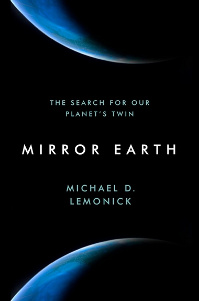
What’s happening is this: The software I use to display the book cover and progress bar is no longer being maintained by its creator, and the program has become flaky. I’ve discovered more and more that certain books will not display properly, so that although I can enter them in the configuration file, nothing shows up in the sidebar on the home page. As a result, I’m searching for alternatives that will display titles like Mirror Earth and anything else I’m currently reading.
But even though I’m early on in my progress through Lemonick’s book, I can already recommend it for the overview it provides. Lemonick writes for TIME and has written skillfully about astronomy’s history (William and Caroline Herschel were the topic of a recent book) and cosmology. He was an early entrant into exoplanet books with 1998’s Other Worlds. In short, Lemonick knows what he’s up to, and he offers the general reader a concise set of discussions with major exoplanet figures and a cogent history of how the field developed.
Astrometry was an early entrant in the exoplanet hunt as astronomers hoped to identify the side-to-side motion of a star being tugged by its planet, but early ‘discoveries’ made with the method proved bogus, and radial velocity emerged as the technique of choice, focusing on the movement of the star to and away from the Earth as measured by Doppler shift. We soon learned the effectiveness of transits (Kepler uses this method) and investigated gravitational lensing and, in rare cases, succeeded at direct imaging. What other methods will emerge?
As I proceed with the book, I’m also looking at recent news from the planet hunting HiCIAO ( High Contrast Instrument for the Subaru Next Generation Optics), used by an international team with the Subaru Telescope on Mauna Kea. HiCIAO has ways of blocking out the central star to help astronomers detect faint objects like planets or dust disks around it. The new work presents studies of the disk around the young star (about 9 million years old) HD 135344B, some 460 light years from Earth in the constellation Lupus. The disk under measurement is 20 billion kilometers in radius, which is about five times greater than Neptune’s distance from the Sun.
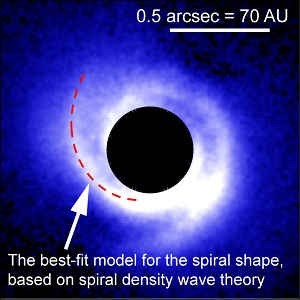
This is intriguing stuff because the team is looking at a spiral disk structure with two discernible arms. Applying density wave theory to the data, the researchers conclude that planets embedded within the disk may account for the spiral shape, and in doing so, they may be revealing another way of detecting exoplanets. The idea here is that regions of enhanced density develop inside a rotating disk because of differential rotation. A planet within the disk could produce the kind of density wave that results in the formation of just this kind of spiral structure. From the paper: “While we cannot uniquely identify the origin of these spirals, planets embedded in the disk may be capable of exciting the observed morphology. Assuming that this is the case, we can make predictions on the locations and, possibly, the masses of the unseen planets.”
Image: A comparison of the fit between the theoretical model and observational data. The red dashed line represents the shape of the disk based on modeling from density wave theory. The image shows that the data conform to the predictions of the theory and supports an explanation for the development of the structure in terms of this theory’s model. (Credit: NAOJ).
So far no planet candidate has emerged — we are simply considering the possibility that a planet is the cause of the density wave. But the use of density wave theory in measuring a protoplanetary disk helps us to understand how spiral disks form, and it may develop into a more precise way to detect exoplanets. The paper on this work suggests that HiCIAO may be capable of detecting the indirect signatures of planets down to 0.05 Jupiter mass, but it will take future observations at other wavelengths to see whether such predictions are borne out in fact.
The paper is Muto et al., “Discovery of Small-Scale Spiral Structures in the Disk of SAO 206462 (HD 135344B): Implications for the Physical State of the Disk from Spiral Density Wave Theory,” in Astrophysical Journal Letters 748 (April 2012), L22, 2012 (abstract).

Alpha Centauri in Perspective
In his new article on Alpha Centauri in Astronomy & Geophysics, Martin Beech (Campion College, University of Regina) noted that the Alpha Centauri stars seem to go through waves of scientific interest. Beech used Google’s Ngram Viewer to look for references to the system in both the scientific literature as well as general magazines and newspapers, finding that there is a 30-year interval between peaks of interest. The figure is suspiciously generational, and Beech wonders whether it reflects an awakening of interest in this nearby system as each generation of scientists and publishers arises.
I mentioned on Christmas Eve that the Beech paper was a real gift for the holidays, and for those of us who try to track developments about Alpha Centauri, it certainly is, drawing together recent work and commenting with care on the findings. The big issue for now is the existence of planets around these stars, a question Centauri B b will begin to answer if it can be confirmed. Everyone from astrophysicists to science fiction authors has noted at one time or another that we may have planets around all three of these stars, no doubt fueling that thirty-year spike Beech identified.
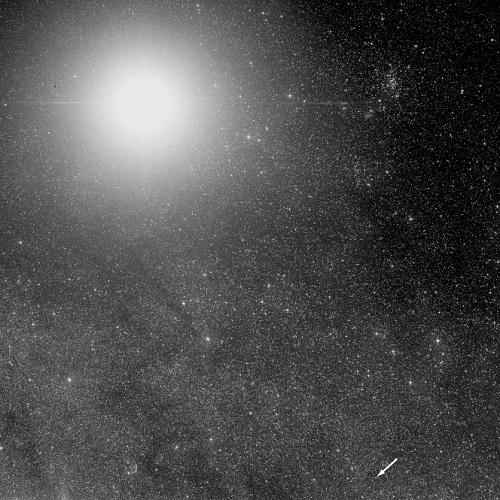
Image: Despite the overexposure of Centauri A and B that fuses the two stars into one at top left, I like it because it reveals Proxima Centauri (shown by the arrow at bottom right), an indication of how distant this nearest star to the Sun is from the two larger stars. Credit: 1-Meter Schmidt Telescope, ESO.
I remember a long-ago sixth grade afternoon when I asked the teacher, after a presentation about astronomy, whether the nearest star had planets like ours around it. After class, she slipped me a book to look at whose title is long lost to memory, but I recall it being stated with confidence that planets were all but impossible around binary stars. Now we know better, for we have planets around binaries elsewhere. As for Alpha Centauri, it was in 1997 that Paul Wiegert and Matt Holman showed that planetary orbits were viable here out to about 4 AU around Centauri A and B.
That would seem to rule out gas giants, which presumably would have formed beyond the snow line at roughly the same 4 AU and beyond, but terrestrial planets in closer orbits are still allowed. Beech runs through the recent scholarship for Centauri A and B, most of which shows the likelihood of planet formation, though in at least one case with a serious restriction:
Guedes et al.(2008) and Thébault et al. (2009) additionally find that planets should have formed around a Cen B. Assuming an initial co-planar distribution of planetesimals, Guedes et al. argue that multiple 1-2 MEarth planets might reside within the region 0.5-1.5 au from a Cen B. Taking into account the details of planetesimal encounters and impact velocities, however, Thébault and co-workers argue that planet formation is only favoured within a restricted zone of 0.5 au about a Cen B. At this stage it will be the discovery of additional planets, with orbits well beyond that of a Cen Bb, that will guide the development of next-generation planetesimal accretion models.
For that matter, can we assume that the current orbital characteristics of Centauri A and B are those of the initial system? In the paper by Philippen Thébault and team referenced above, the authors point out that the odds of Alpha Centauri having gone through a close encounter with a nearby star system that could have affected stellar orbits may be as high as 1 in 2. It’s regrettable, then, that we have no knowledge of the cluster that spawned Alpha Centauri or the effects such encounters might have had. We do know that this system formed from a different cluster than the Sun — our stars are close now but the condition is temporary, and Alpha Centauri was likely 1 to 2 billion years old when our Solar System was beginning to form.
You’ll find most of the papers Beech refers to, the recent ones anyway, discussed in earlier Centauri Dreams posts, and you can use the search function to track them down by author. The same is true of work on Proxima, the M-dwarf that accompanies Centauri A and B, or at least is located at roughly the same distance and shares the same proper motion. It’s hard to believe that the three don’t form a single system, especially given their common chemical composition, but it has always been a tough call going back to the work of Joan Gijsbertus Voûte, who announced the first parallax findings about Proxima in 1917. Voûte pondered whether the three stars were physically connected or ‘members of the same drift,’ and Beech notes that despite the following century of observations, we are still working on the same question.
It’s also been amply demonstrated that both gas giants and rocky worlds can form around M-dwarfs, so while we’re gradually ruling out larger planets around Proxima, we’re far from being able to declare there are no terrestrial planets orbiting it. Here again we’ve run through the numbers in Centauri Dreams in recent memory, but Beech sifts through the findings, which increasingly exclude planets of Jupiter-mass, and he notes in particular the work of Michael Endl and team, which argues that any planet greater than two Earth masses within Proxima’s habitable zone should have been detected by now. That leaves room for smaller worlds in interesting places.
We can also exclude various kinds of planets around Centauri A and B:
With respect to a Cen AB, the five-year radial velocity survey starting in 1992 conducted by Endl et al. (2001) revealed the following constraints: for a Cen A there are no planets more massive than 1 MJupiter within 2 au, and no 2 MJupiter or larger mass planets within 4 au; for a Cen B there are no planets more massive than 1.5 Jupiter within 2 au, and no planets more massive than 2.5 MJupiter within 4 au. On the larger scale, a deep CCD imaging survey of the region immediately surrounding a Cen AB revealed no co-moving companions with masses greater than 15 MJupiter at distances 100-300 au (Kervella and Thévenin 2007).
Thus the search goes on, and Beech believes the current surveys will be able to dampen the noise in the radial velocity signal of an Earth mass planet in a 1 AU orbit around Centauri A or B with about five more years of data gathering. Although the HARPS team at La Silla was first with an Alpha Centauri planet candidate, the hunt for an Earth-class world in a habitable orbit has only intensified. Dedicated Alpha Centauri search programs are in progress not just via HARPS but also through a Yale University program at Cerro Tololo (this one backed by the Planetary Society as well) and through the HERCULES spectrograph at Mt. John Observatory in New Zealand.
I’ve only touched on the highlights of this rich paper, whose bibliography alone makes it worth seeking out. The reference is Beech, “A journey through time and space: Alpha Centauri,” Astronomy & Geophysics, Volume 53, Issue 6, pp. 6.10-6.16 (abstract).

Best Wishes for a Stellar Holiday
Martin Beech has written a superb summary of Alpha Centauri studies for the Royal Astronomical Society’s journal Astronomy and Geophysics, covering recent work up to and including the discovery of planet candidate Centauri B b. A fine holiday gift! I had been hoping to write it up this morning, but Christmas events, not least of which is the need for some last minute shopping, have made that impossible. So I’ll save this impressive work for later in the week. In the meantime, let me wish all Centauri Dreams readers best wishes for a joyous holiday season. See you in a few days.

New Models of Galactic Expansion
Unexpectedly waking this morning despite Mayan prophecy, I suddenly remembered the storms that had kept me up for an hour during the night. There was little rain, but the winds were gusting and I could hear trees branches slapping against the siding and dogs baying inside nearby houses. When I got up to look out the window, city light under the overcast created a dim bronze aura. You would think it was the end of the world, but this morning I was delighted to see in the paper that a gathering of spiritualists in Mexico says we are not at the end of the world but the beginning of a new one. Up ahead: New powers of telepathy and levitation for us all.
I was never into the Mayan thing enough to know whether it involved the end of just our world or the entire cosmos, but I would guess that any extraterrestrial civilizations, if they’re out there, have likely had their share of doomsday prophets. And as I await my new powers of levitation (not working yet, but maybe by this afternoon), I’m thinking about Fermi’s ‘where are they’ question as we consider our place in the universe. All such speculation plays into so-called ‘percolation theory,’ which was developed to analyze the diffusion of liquids through porous materials, and which can be invoked to study growing civilizations. How do civilizations spread?
Modeling Interstellar Expansion
This is exactly what Thomas Hair and Andrew Hedman (Florida Gulf Coast University) ponder in a new paper modeling the spatial emergence of an interstellar civilization. Percolation theory asks what happens when we pour a liquid onto porous material, tracing its path from hole to hole. But the authors work the question around to this: What happens when a civilization spreads out into the galaxy from a distant star and continues to expand its presence at an ever-increasing rate. Will a colony inevitably get close enough to the Earth that we will be able to notice its presence?
Many explanations for the Fermi paradox exist, but Hair and Hedman want to look at the possibility that starflight is so long and difficult that it takes vast amounts of time (measured in geologic epochs) to colonize on the galactic scale. Given that scenario, large voids within the colonized regions may still persist and remain uninhabited. If the Earth were located inside one of these voids we would not be aware of the extraterrestrial expansion. A second possibility is that starflight is so hard to achieve that other civilizations have simply not had time to reach us despite having, by some calculations, as much as 5 billion years to have done so (the latter figure comes from Charles Lineweaver, and I’ll have more to say about it in a moment).
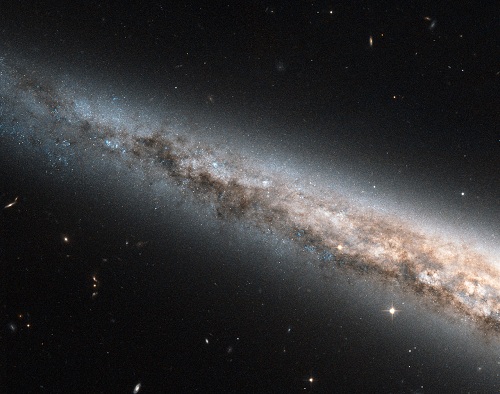
Image: A detailed view of part of the disc of the spiral galaxy NGC 4565. Have technological civilizations had time enough to spread through an entire galaxy, and if so, would they be detectable? Credit: ESA/NASA.
The authors work with an algorithm that allows modeling of the expansion from the original star, running through iterations that allow emigration patterns to be analyzed in light of these prospects. It turns out that in 250 iterations, covering 250,000 years, a civilization most likely to emigrate will travel about 500 light years, for a rate of expansion that is approximately one-fourth of the maximum travel speed of one percent of the speed of light, the conservative figure chosen for this investigation. A civilization would spread through the galaxy in less than 50 million years.
These are striking numbers. Given five billion years to work with, the first civilization to develop starfaring capabilities could have colonized the Milky Way not one but 100 times. The idea that it takes billions of years to accomplish a galaxy-wide expansion fails the test of this modeling. Moreover, the idea of voids inside colonized space fails to explain the Fermi paradox as well:
…while interior voids exist at lower values of c initially, most large interior voids become colonized after long periods regardless of the cardinal value chosen, leaving behind only relatively small voids. In an examination of several 250 Kyr models with a wide range of parameters, the largest interior void encountered was roughly 30 light years in diameter. Since humans have been broadcasting radio since the early 20th century and actively listening to radio signals from space since 1960 (Time 1960), it is highly unlikely that the Earth is located in a void large enough to remain undiscovered to the present day. It follows that the second explanation of Fermi’s Paradox (Landis 1998) is not supported by the model presented.
There are mitigating factors that can slow down what the authors call the ‘explosively exponential nature’ of expansion, in which a parent colony produces daughter colonies and the daughters continue to do the same ad infinitum. The paper’s model suggests that intense competition for new worlds can spring up in the expanding wavefront of colonization. At the same time, moving into interior voids to fill them with colonies slows the outward expansion. But even models set up to reduce competition between colonies present the same result: Fermi’s lunchtime calculations seem to be valid, and the fact that we do not see evidence of other civilizations suggests that this kind of galactic expansion has not yet taken place.
Temporal Dispersion into the Galaxy
I can’t discuss Hair and Hedman’s work without reference to Hair’s earlier paper on the expansion of extraterrestrial civilizations over time. Tom had sent me this one in 2011 and I worked it into the Centauri Dreams queue before getting sidetracked by preparations for the 100 Year Starship symposium in Orlando. If I had been on the ball, I would have run an analysis of Tom’s paper at the time, but the delay gives me the opportunity to consider the two papers together, which turns out to work because they are a natural fit.
For you can see that Hair’s spatial analysis goes hand in glove with the question of why an extraterrestrial intelligence might avoid making its presence known. Given that models of expansion point to a galaxy that can be colonized many times over before humans ever emerged on our planet, let’s take up a classic answer to the Fermi paradox, that the ‘zoo hypothesis’ is in effect, a policy of non-interference in local affairs for whatever reason. Initially compelling, the idea seems to break down under close examination, given that it only takes one civilization to act contrary to it.
But there is one plausible scenario that allows the zoo hypothesis to work: The influence of a particularly distinguished civilization. Call it the first civilization. What sort of temporal head start would this first civilization have over later arrivals?
Hair uses Monte Carlo simulations, drawing on the work of Charles Lineweaver and the latter’s estimate that planets began forming approximately 9.3 billion years ago. Using Earth as a model and assuming that life emerged here about 600 million years after formation, we get an estimate of 8.7 billion years ago for the appearance of the first life in the Milky Way. Factoring in how long it took for complex land-dwelling organisms to evolve (3.7 billion years), Lineweaver concludes that the conditions necessary to support intelligent life in the universe could have been present for at least 5.0 billion years. At some point in that 5 billion years, if other intelligent species exist, the first civilization arose. Hair’s modeling goes to work on how long this civilization would have had to itself before other intelligence emerged. The question thus has Fermi implications:
…even if this first grand civilization is long gone . . . could their initial legacy live on in the form of a passed down tradition? Beyond this, it does not even have to be the first civilization, but simply the first to spread its doctrine and control over a large volume of the galaxy. If just one civilization gained this hegemony in the distant past, it could form an unbroken chain of taboo against rapacious colonization in favour of non-interference in those civilizations that follow. The uniformity of motive concept previously mentioned would become moot in such a situation.
Thus the Zoo Hypothesis begins to look a bit more plausible if we have each subsequent civilization emerging into a galaxy monitored by a vastly more ancient predecessor who has established the basic rules for interaction between intelligent species. The details of Hair’s modeling are found in the paper, but the conclusions are startling, at least to me:
The time between the emergence of the first civilization within the Milky Way and all subsequent civilizations could be enormous. The Monte Carlo data show that even using a crowded galaxy scenario the first few inter-arrival times are similar in length to geologic epochs on Earth. Just what could a civilization do with a ten million, one hundred million, or half billion year head start (Kardashev 1964)? If, for example, civilizations uniformly arise within the Galactic Habitable Zone, then on these timescales the first civilization would be able to reach the solar system of the second civilization long before it evolved even travelling at a very modest fraction of light speed (Bracewell 1974, 1982; Freitas 1980). What impact would the arrival of the first civilization have on the future evolution of the second civilization? Would the second civilization even be allowed to evolve? Attempting to answer these questions leads to one of two basic conclusions, the first is that we are alone in the Galaxy and thus no one has passed this way, and the second is that we are not alone in the Galaxy and someone has passed this way and then deliberately left us alone.
The zoo hypothesis indeed. A galactic model of non-interference is a tough sell because of the assumed diversity between cultures emerging on a vast array of worlds over time. But Hair’s ‘modified zoo hypothesis’ has great appeal. It assumes that the oldest civilization in the galaxy has a 100 million year head start, allowing it to become hugely influential in monitoring or perhaps controlling emerging civilizations. We would thus be talking about the possibility of evolving similar cultural standards with regard to contact as civilizations follow the lead of this assumed first intelligence when expanding into the galaxy. It’s an answer to Fermi that holds out hope we are not alone, and I’ll count that as still another encouraging thought on the day the world didn’t end.
The paper just discussed is Hair, “Temporal dispersion of the emergence of intelligence: an inter-arrival time analysis,” International Journal of Astrobiology Vol. 10 Issue 02 (April 2011), pp 131-135 (abstract). The paper on spatial dispersion is Hair and Hedman, “Spatial dispersion of interstellar civilizations: a probabilistic site percolation model in three dimensions,” International Journal of Astrobiology Vol. 12, Issue 01 (January 2013), pp 45-52 (abstract).

Tightly Spaced Habitable Zone Candidates
We saw yesterday how a newly refined radial velocity technique allowed researchers to identify five planet candidates around the nearby star Tau Ceti. The latter has long held fascination for the exoplanet minded because it’s a G-class star not all that different from the Sun, and one of the planets around it — if confirmed — appears to be in its habitable zone. But smaller stars remain much in the news as well, as witness Gl 667C, a red dwarf (M-class) star in a triple system that also contains two closely spaced K-class stars with a semimajor axis of 1.82 AU.
M-class stars offer a lot to planet hunters, as new work using the HARPS spectrograph at La Silla is making clear. For one thing, a planet of a given size induces more radial velocity variation around a low-mass star than around a larger one, making the planet easier to spot. For another, red dwarfs are dimmer than G and K-class stars, with a habitable zone much closer to the star. Here again we get a larger radial velocity wobble than we would find with a larger star.
Philip Gregory (University of British Columbia) has performed a re-analysis of the HARPS data on Gl 667C that is getting play in the press because it identifies not one but three planets in the habitable zone. The star has about a third of the mass of the Sun, so according to Gregory’s figures, a habitable zone planet there produces seven times the radial velocity signature that a similar planet around a G-class star would generate. In 2011 Gl 667C was already known to be orbited by at least one planet, Gl 667C b, with a 7.2 day orbit, and there was evidence for other worlds. Later work confirmed the planet Gl 667C c in a 28-day orbit in the habitable zone.
All of this, says Gregory in the paper on his new work, has driven a serious effort to improve the statistical tools used to analyze radial velocity data, and we saw yesterday how Mikko Tuomi (University of Hertfordshire) and team put their own methods to work on Tau Ceti. Using his own algorithms, Gregory has already been able to confirm the existence of a second planet around 47 Ursae Majoris, but Gl 667C will draw more attention because of the dramatic placement of the planet candidates here. In this case, the astronomer included stellar jitter and orbital drift factors to re-analyze the HARPS data using Bayesian methods to refine the probability estimates.
The result: The detected signals include the already established planets in 7.2 and 28.1-day orbits, but also show possible planets in 30.8 (d), 38.8 (e), 53.2 and 91.3-day orbits (f). Gregory discounts the 53.2-day signal because it seems to be the result of surface activity on the star. All these candidates are more massive than Earth, but e is only 2.4 Earth masses. The signals at 30.8 and 38.8 days, if confirmed, would join Gl 667C c as planets in the habitable zone. Gregory finds that the 91.3 day orbit would take that planet inside the outermost edge of the habitable zone, although its eccentric orbit would keep it outside the HZ for the majority of time.
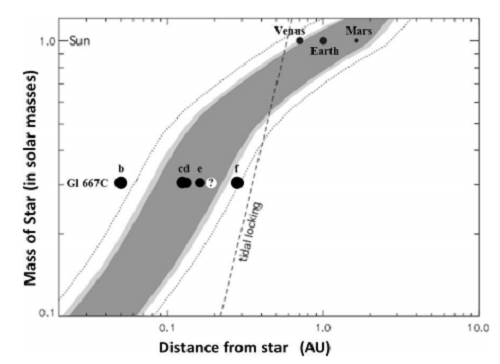
Image: The darker area is the orbital region that remains continuously habitable during at least 5 Gyr as a function of the stellar mass (Selsis et al. 2007). The light grey region gives the theoretical inner (runaway greenhouse) and outer limits with 50% cloudiness, with H2O and CO2 clouds, respectively. The dotted boundaries correspond to the extreme theoretical limits, found with a 100% cloud cover. The dashed line indicates the distance at which a 1 M? planet on a circular orbit becomes tidally locked in less than 1 Gyr. Credit: Philip Gregory.
The scientist is careful to note that new simulations will be needed to determine which of the planetary signals are consistent with a stable planetary system. Look particularly at the closeness of the 28.1 and 30.8 day orbits, where the semi-major axis differs by a mere 0.007 AU. This sets up a closest approach, as Gregory notes, every 323 days, doubtless a fascinating astronomical spectacle from the surfaces of these possible worlds. And the author cites the Kepler mission’s own findings of systems with close planetary separations, including Kepler 36 b and c (0.014 AU), Kepler 42 b and d (0.0038 AU), and KOI 55b and c (0.0016 AU).
We may have to start getting used to solar systems with close planetary separations, unlike the relatively spacious inner system we see around the Sun. I’m reminded of something Steve Vogt (UC-Santa Cruz) said in the news release on the Tau Ceti story: “We are now beginning to understand that Nature seems to overwhelmingly prefer systems that have multiple planets with orbits of less than one hundred days. This is quite unlike our own solar system where there is nothing with an orbit inside that of Mercury. So our solar system is, in some sense, a bit of a freak and not the most typical kind of system that Nature cooks up.” Vogt was not speaking of M-dwarfs, of course, but the statement has no better illustration than Gl 667C’s possible planets.
The paper is Gregory, “Additional Keplerian Signals in the HARPS data for Gliese 667C from a Bayesian Re-analysis” (preprint).


